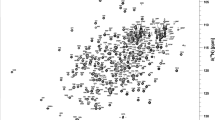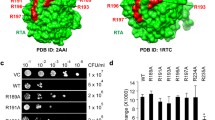Abstract
Based on the tertiary structure of the ribosome-inactivating protein α-sarcin, domains that are responsible for hydrolyzing ribosomes and naked RNA have been dissected. In this study, we found that the head-to-tail interaction between the first amino β-strand and the last carboxyl β-strand is not involved in catalyzing the hydrolysis of ribosomes or ribonucleic acids. Instead, a four-strand pleated β-sheet is indispensable for catalyzing both substrates, suggesting that α-sarcin and ribonuclease T1 (RNase T1) share a similar catalytic center. The integrity of an amino β-hairpin and that of the loop L3 in α-sarcin are crucial for recognizing and hydrolyzing ribosomes in vitro and in vivo. However, a mutant protein without the β-hairpin structure, or with a disrupted loop L3, is still capable of digesting ribonucleic acids. The functional involvement of the β-hairpin and the loop L3 in the sarcin stem/loop RNA of ribosomes is demonstrated by a docking model, suggesting that the two structures are in essence naturally designed to distinguish ribosome-inactivating proteins from RNase T1 to inactivate ribosomes.
Similar content being viewed by others
References
Ackerman EJ, Saxena SK, Ulbrich N. α-Sarcin causes a specific cut in 28S rRNA when microinjected intoXenopus oocytes. J Biol Chem 263:17076–17083;1988.
Campos-Olivas R, Bruix M, Santoro J, Martinez del Pozo A, Lacadena J, Gavilanes JG, Rico M.1H and15N nuclear magnetic resonance assignment and secondary structure of the cytotoxic ribonuclease α-sarcin. Protein Sci 5:969–972;1996.
Campos-Olivas R, Bruix M, Santoro J, Martinez del Pozo A, Lacadena J, Gavilanes JG, Rico M. Structural basis for the catalytic mechanism and substrate specificity of the ribonuclease α-sarcin. FEBS Lett 399:163–165;1996.
Chan YL, Endo Y, Wool IG. The sequence of the nucleotides at the α-sarcin cleavage site in rat 28S ribosomal ribonucleic acid. J Biol Chem 258:12768–12770;1983.
Cheung J-I, Wang Y-R, Lin A. Substrate specificity of monomeric and dimeric α-sarcin. FEBS Lett 386:60–64;1996.
Dever TE, Glynias MJ, Merrick W. GTP-binding domain: Three consensus sequence elements with distinct spacing. Proc Natl Acad Sci USA 84:1814–1818;1987.
Diaz J-J, Rhoads DD, Roufad J. PCR-mediated chemical mutagenesis of cloned duplex DNAs. Biotechniques 11:204–209;1991.
Endo Y, Wool IG. The site of action of α-sarcin on eukaryotic ribosomes. J Biol Chem 257:9054–9060;1982.
Endo Y, Huber PW, Wool IG. The ribonuclease activity of the cytotoxin α-sarcin. J Biol Chem 258:2662–2667;1983.
Endo Y, Chan Y-L, Lin A, Tsurugi K, Wool IG. The cytotoxins α-sarcin and ricin retain their specificity when tested on a synthetic oligoribonucleotide (35-mer) that mimics a region of 28 S ribosomal ribonucleic acid. J Biol Chem 263:7917–7920;1989.
Endo Y, Gluck A, Chan Y-L, Tsurugi K, Wool IG. RNA-protein interaction. An analysis with RNA oligonucleotides of the recognition by α-sarcin of a ribosomal domain critical for function. J Biol Chem 265:2216–2222;1990.
Gluck AE, Wool IG. Determination of the 28 S ribosomal RNA identity element (G4319) for alpha-sarcin and the relationship of recognition to selection of the catalytic site. J Mol Biol 256:838–848;1996.
Haun MF, Wirth M, Ruterjans J. Colorimetric investigation of thermal stability and ligand-binding characteristics of disulfide-bond-cleaved ribonuclease T1. Eur J Biochem 227:516–523;1995.
Hill C, Dodson G, Heinemann W, Saenger W, Mitsui Y, Nakamura K, Borisov S, Tischenko G, Polyakov K, Pavlovsky S. The structural and sequence homology of a family of microbial ribonucleases. Trends Biochem Sci 8:364–369;1983.
Huang K-C, Hwang Y-Y, Hwu L, Lin A. Characterization of a new ribotoxin gene (c-sar) fromAspergillus clavatus. Toxicon 35:383–392;1997.
Hwu L, Chen D-T, Lin T-H, Lin A. Residue Lys112 in the ribosome-inactivating protein influences the recognition of the sarcin domain of ribosomes, submitted.
Jacquier A. Self-splicing group II and nuclear pre-mRNA introns: How similar are they? Trends Biochem Sci 15:351–354;1990.
Kao R, Davies J. Fungal ribotoxins: A family of naturally engineered targeted toxins. Biochem Cell Biol 73:1151–1169;1995.
Kao R, Shea JE, Davies J, Holden DW. Probing the active site of mitogillin, a fungal ribotoxin. Mol Microbiol 29:1019–1027;1998.
Kao R, Davies J. Molecular dissection of mitogillin reveals that the fungal ribotoxins are a family of natural genetically engineered ribonucleases. J Biol Chem 274:12576–12582;1999.
Kenan DJ, Query CC, Keene JD. RNA recognition: Towards identifying determinants of specificity. Trends Biochem Sci 16:214–220;1991.
Lacadena J, Martinez del Pozo A, Barber JL, Mancheno JM, Gasset M, Onaderra M, Lopez-Otin C, Ortega S, Garcia J, Gavilanes JG. Overproduction and purification of biologically active native fungal α-sarcin inEscherichia coli. Gene 142:147–151;1994.
Lacadena J, Mancheno JM, Martinez-Ruiz A, Martinez del Pozo A, Gasset M, Onaderra M, Gavilanes JG. Substitution of histidine-137 by glutamine abolishes the catalytic activity of the ribosome-inactivating protein α-sarcin. Biochem J 309:581–586;1995.
Lamy B, Davies J. Isolation and nucleotide sequence of theAspergillus restrictus gene coding for the ribonucleolytic toxin restrictocin and its expression inAspergillus nidulans: The leader sequence protects producing strains from suicide. Nucleic Acids Res 19:1001–1006;1991.
Liao Y-D, Wang J-J. Yolk granules are the major compartment for bullfrog (Rana catesbeiana) oocyte-specific ribonuclease. Eur J Biochem 222:215–220;1994.
Lin A, Huang R-G. Hydrolysis of ribosomes by electrophoretically blotted ribotoxin. Biotechniques 17:636–637;1994.
Lin A, Huang K-C, Hwu L, Tzean SS. Production of type II ribotoxins byAspergillus species and related fungi in Taiwan. Toxicon 33:105–110;1995.
Ling J, Liu W, Wang TP. Cleavage of supercoiled double-stranded DNA by several ribosome-inactivating proteins in vitro. FEBS Lett 345:143–146;1994.
Mancheno JM, Gasse M, Lacadena J, Martinez del Pozo A, Onaderra M, Gavilanes JG. Predictive study of the conformation of cytotoxic protein α-sarcin: A structural model to explain α-sarcin-membrane interaction. J Theor Biol 172:259–267;1995.
Martinez del Pozo A, Gasset M, Onaderra M, Gavilanes JG. Conformational study of the antitumor protein α-sarcin. Biochim Biophys Acta 953:280–288;1988.
Martinez-Oyanedel J, Choe HW, Heinemann U, Saenger W. Ribonuclease T1 with free recognition and catalytic site: Crystal structure analysis at 1.5 Å resolution. J Mol Biol 222:335–352;1991.
Miller SP, Bodley JW. α-Sarcin cleavage of ribosomal RNA is inhibited by binding of elongation factor G or thiostrepton to the ribosome. Nucleic Acids Res 19:1657–1660;1991.
Oka T, Aoyama Y, Natori Y, Katano T, Endo Y. An efficient expression system for a variant form of the cytotoxic protein α-sarcin inEscherichia coli. Biochim Biophys Acta 1130:182–188;1992.
Pace CN, Grimsley GR, Thomson JA, Barnett BJ. Conformational stability and activity of ribonuclease T1 with zero, one, and two intact disulfide bonds. J Biol Chem 263:11820–11825;1988.
Pace CN, Heinemann U, Hahn U, Saenger W. Ribonuclease T1: Structure, function, and stability. Angew Chem Int Ed Engl 30:343–360;1991.
Sacco G, Drickamer K, Wool IG. The primary structure of the cytotoxin α-sarcin. J Biol Chem 258:5811–5818;1983.
Schindler DG, Davies JE. Specific cleavage of ribosomal RNA by alpha sarcin. Nucleic Acids Res 4:1097–1110;1977.
Sevcik J, Sanishvili RG, Pavlovsky AG, Polyakov KM. Comparison of active sites of some microbial ribonucleases: Structural basis for guanylic specificity. Trends Biochem Sci 15:158–62;1990.
Steyaert J. A decade of protein engineering on ribonuclease T1: Atomic dissection of the enzyme-substrate interactions. Eur J Biochem 247:1–11;1997.
Szewczak AA, Chan YL, Moor PB, Wool IG. On the conformation of the alpha sarcin stemloop of 28S rRNA. Biochimie 78:871–877;1991.
Szewczak AA, Moore PB. The sarcin/ricin loop, a modular RNA. J Mol Biol 247:81–98;1995.
Wnendt S, Felske-Zech H, Henze P-PC, Ulbrich N, Stahl U. Characterization of the gene encoding α-sarcin, a ribosome-inactivating protein secreted byAspergillus giganteus. Gene 124:239–244;1993.
Wool IG. The mechanism of action of the cytotoxic nuclease α-sarcin and its use to analyse ribosome structure. Trends Biochem Sci 9:14–17;1984.
Wool IG, Gluck A, Endo Y. Ribotoxin recognition of ribosomal RNA and a proposal for the mechanism of translocation. Trends Biochem Sci 17:266–269;1992.
Yang R, Kenealy W. Effects of amino-terminal extensions and specific mutations on the activity of restrictocin. J Biol Chem 267:16801–16905;1992.
Yang X, Moffat K. Insights into specificity of cleavage and mechanism of cell entry from the crystal structure of the highly specificAspergillus ribotoxin, restrictocin. Structure 4:837–852;1996.
Author information
Authors and Affiliations
Rights and permissions
About this article
Cite this article
Hwu, L., Huang, KC., Chen, DT. et al. The action mode of the ribosome-inactivating protein α-sarcin. J Biomed Sci 7, 420–428 (2000). https://doi.org/10.1007/BF02255817
Issue Date:
DOI: https://doi.org/10.1007/BF02255817




